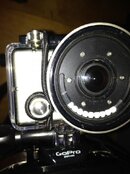Its very unfortunate that this has happened to you, I had a loss of 2 GoPro HD1 cameras in a EOM 3D housing. It was a freak accident where I was diving with a very playful seal in 1-2m of water and he was bumping the camera a bit. I hadn't noticed the cameras had shut off and continued on for about 30 minutes, when I got to the surface the first thing I noticed was the fogging inside the housing. The cameras were both off and only a few drops of water were visible in the housing the latch was loosened on the housing but it was still closed.
At first I didn't know what happened but I managed to recover the corrupted video file from one of the cameras, it showed the moment the seal bumped me that a few seconds later a bit of water came into the housing. There was a plasticy type sound which I assume was when the latch loosened due to the impact and then 30 seconds later the video went all weird and then died. I tested the housing in a chamber to see if it had any issues but it was fine as this was before I saw the video and I assumed it was a housing fault. Both cameras were unrecoverable and so I realized my biggest fear of the 3D housing which is risking 2 cameras at once, luckily I had been in touch with gopro and let them know what had happened and what I discovered the cause was. They gave me a good discount for me to replace my 2 lost cameras which I was very thankful for.
@Robint all the 3rd party housings are still just modified GoPro housing's and they all suffer the same minor design flaw by GoPro, under pressure on some housings the latch may come loose as the white gasket compresses and takes away some of the pressure keeping the latch tight. In very rare circumstances this can completely open the latch if bumped in a certain direction or possibly even water movement from currents or moving of the camera could unlatch this. It will not open at depth though as the pressure is still keeping the housing closed until you are very close to the surface which is the most dangerous time as the reduced pressure may allow it to open. Im surprised Backscatter doesnt even acknowledge that the gopro housing may have this issue in some cases, mako have released a stronger rubber band but I just use regular thick ones and replace them each time. A large pack of these costs around $1 so they will last me a long time
This is a design flaw of the latch system but can be fixed easily with a rubber band over the latch preventing it from opening, or on your accent from a dive during your safety stop check the latch and ensure it is properly seated. I do both due to my past experience but only a rubber band would have saved my 2 cameras in my freak accident.
There is a 3rd party latch and possibly others may come up with something, Im not sure if the GoPro dive housing has made any modifications to the latch setup as I don't have one yet but to me it looks the same.
Hmm this is actualy quite worrying if this happens more frequently. So ur saying that just putting regular rubber bands help? I think that the dive housing might be tougher than the regular ones. I feel that the dive housing is tighter than the regular ones, like harder to click in. IMO though





